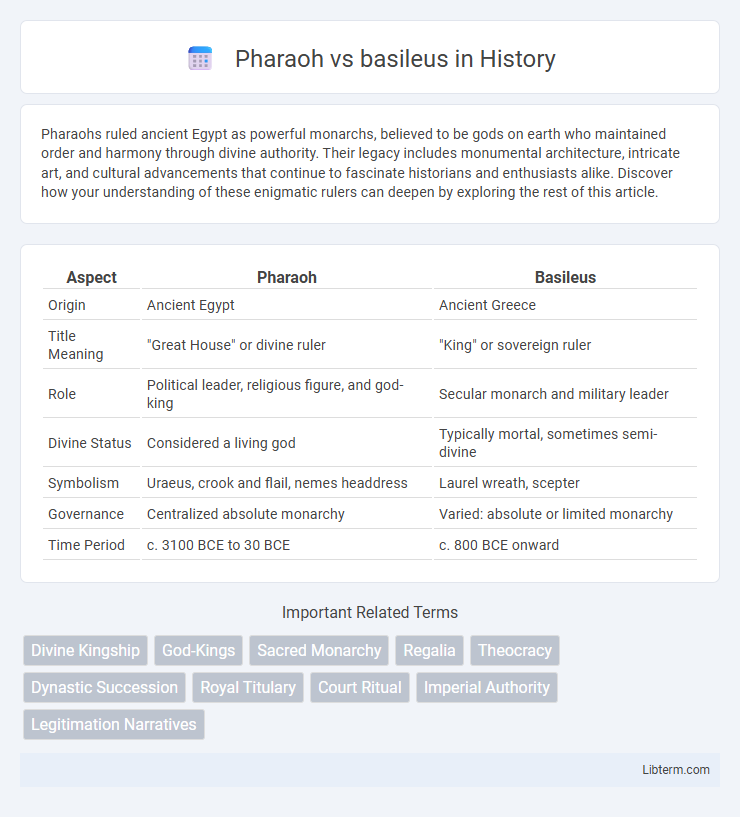Pharaohs ruled ancient Egypt as powerful monarchs, believed to be gods on earth who maintained order and harmony through divine authority. Their legacy includes monumental architecture, intricate art, and cultural advancements that continue to fascinate historians and enthusiasts alike. Discover how your understanding of these enigmatic rulers can deepen by exploring the rest of this article.
Table of Comparison
| Aspect | Pharaoh | Basileus |
|---|---|---|
| Origin | Ancient Egypt | Ancient Greece |
| Title Meaning | "Great House" or divine ruler | "King" or sovereign ruler |
| Role | Political leader, religious figure, and god-king | Secular monarch and military leader |
| Divine Status | Considered a living god | Typically mortal, sometimes semi-divine |
| Symbolism | Uraeus, crook and flail, nemes headdress | Laurel wreath, scepter |
| Governance | Centralized absolute monarchy | Varied: absolute or limited monarchy |
| Time Period | c. 3100 BCE to 30 BCE | c. 800 BCE onward |
Origins of the Titles: Pharaoh and Basileus
The title "Pharaoh" originated in ancient Egypt, derived from the Egyptian term "per-aa," meaning "great house," initially referring to the royal palace before becoming synonymous with the king himself during the New Kingdom period around 1550 BCE. In contrast, "Basileus" emerged in ancient Greece as a term for a king or ruler, rooted in Mycenaean civilization's linear B script and solidified during the classical era, symbolizing sovereignty and political authority within city-states. Both titles reflect distinct cultural and linguistic evolutions: Pharaoh embodies divine kingship intertwined with religious authority, while Basileus denotes secular leadership and governance in the Hellenic world.
Historical Context and Time Periods
Pharaohs ruled ancient Egypt primarily during the Old Kingdom (c. 2686-2181 BCE) through to the Ptolemaic Kingdom (305-30 BCE), symbolizing divine kingship integrated with religious authority. Basileus was the title for Greek kings and later Byzantine emperors, originating in the Mycenaean period (c. 1600-1100 BCE) and evolving through classical Greece into Byzantine sovereignty until 1453 CE. These distinct titles reflect separate cultural, political, and religious frameworks tied to their respective historical contexts and time periods.
Political Structures: Ancient Egypt vs. Greece
The title of Pharaoh in Ancient Egypt embodied both political and religious authority, serving as the divine ruler whose centralized power governed the state with absolute control over law, land, and military. In contrast, the Basileus in ancient Greece, especially during the Mycenaean period, functioned as a king with more limited and often localized powers, frequently sharing or contesting authority within aristocratic councils or city-state assemblies. The political structure of Ancient Egypt favored a theocratic monarchy with a unified bureaucracy, whereas Greek political organization evolved towards fragmented city-states (poleis) emphasizing more participatory or oligarchic governance models.
Religious Authority and Divine Kingship
Pharaohs embodied divine kingship in ancient Egypt, regarded as living gods and intermediaries between the gods and people, maintaining Ma'at (cosmic order) through religious rituals. In contrast, the Greek basileus held a more secular monarchy with limited divine status, often seen as chosen or favored by gods but not incarnations of them. The pharaoh's religious authority was absolute, integrating political power with priestly roles, whereas the basileus typically shared religious functions with established priesthoods.
Roles in Society and Governance
Pharaohs, as divine rulers of ancient Egypt, combined religious authority with political power, serving as intermediaries between gods and people, overseeing law, military, and economic resources. Basileus, a term used for Greek monarchs, functioned primarily as secular leaders with roles in governance, military command, and diplomacy, often supported by aristocratic councils. The pharaoh's role encompassed both spiritual and administrative duties, while the basileus emphasized political sovereignty within a more fragmented and evolving political structure.
Symbols, Regalia, and Iconography
Pharaohs are commonly depicted wearing the double crown (Pschent), symbolizing dominion over Upper and Lower Egypt, alongside the crook and flail representing kingship and fertility. Basileus, the ancient Greek term for king, often appears adorned with the laurel wreath and scepter, symbolizing victory, authority, and divine favor in Hellenic iconography. Both titles utilized distinctive regalia and symbols to communicate sovereign legitimacy and divine connection, revealing cultural differences in the expression of royal power.
Succession and Royal Lineage
Pharaoh succession often followed complex hereditary rules with emphasis on divine right, frequently involving the eldest son or a designated royal heir to maintain continuity within the god-king lineage. Basileus succession in ancient Greece was typically hereditary, passing the kingship to the firstborn male, but could also involve election or appointment in some city-states, reflecting a blend of dynastic and political considerations. Both titles upheld royal lineage significance, with Pharaohs embodying divine authority and Basileus reinforcing civic leadership through lineage and aristocratic legitimacy.
Economic Power and Administration
Pharaohs exercised centralized economic power by controlling vast agricultural lands, directing labor resources through corvee labor systems, and managing wealth via temple economies integral to state administration. Basileis, in contrast, wielded economic influence through decentralized city-states, relying on tribute, trade networks, and aristocratic councils to manage resources and fiscal policies. Administrative structures under Pharaohs combined religious authority and bureaucratic governance, while Basileis often depended on collaborative oligarchies and proto-democratic institutions to oversee economic affairs.
Military Leadership and Campaigns
Pharaohs commanded vast armies, leading military campaigns to expand and defend ancient Egypt's borders, showcasing their role as supreme military leaders and divine warriors. Basileus, the Greek term for king, held authority over military forces primarily in city-states, often relying on hoplite soldiers and naval power in campaigns. Both titles embodied military command, but pharaohs integrated religious legitimacy and centralized control, while basileis exercised power within more fragmented political structures.
Legacy and Influence on Later Civilizations
Pharaohs established centralized theocratic rule in ancient Egypt, shaping religious traditions and monumental architecture that influenced subsequent African and Mediterranean cultures. Basileus, the Greek term for king, signified a shift toward city-state governance and inspired the development of classical political philosophy and Western monarchy concepts. The legacies of both titles underpin modern understandings of sovereignty, governance, and cultural identity across diverse civilizations.
Pharaoh Infographic

 libterm.com
libterm.com